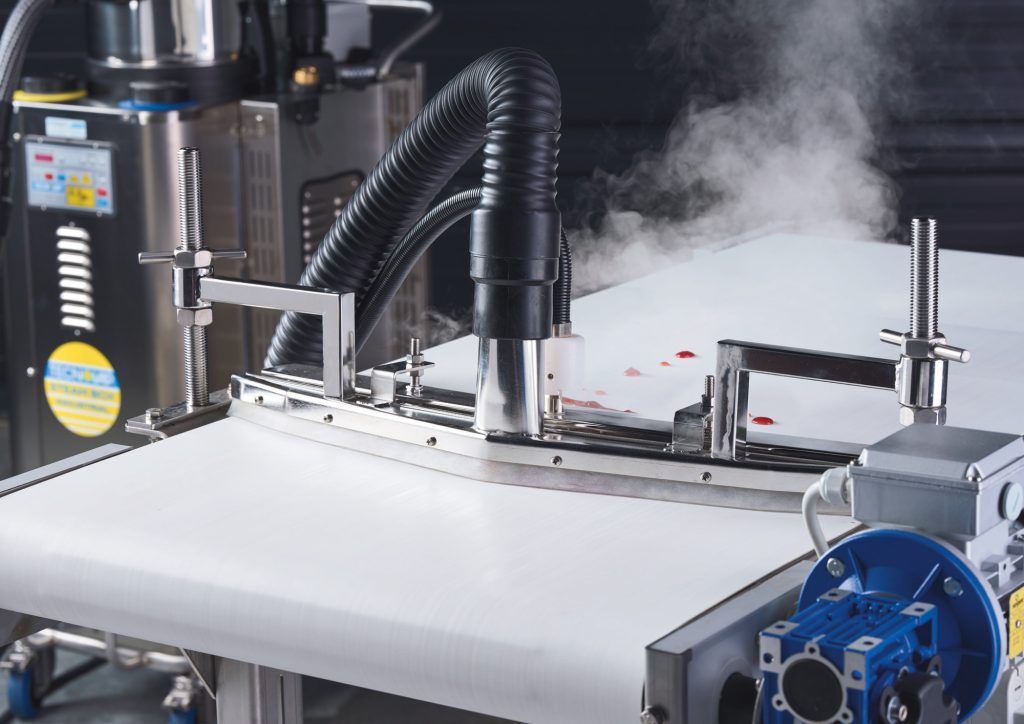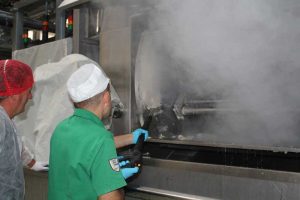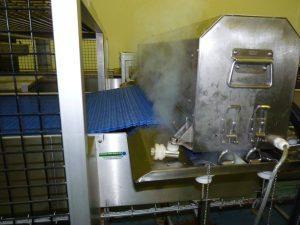Conveyor washing systems are a type of industrial cleaning equipment that has revolutionised the way cleaning is done in various industries. These systems use a conveyor belt to transport items through a series of cleaning stages, such as washing, rinsing, and drying. The items are typically placed on the conveyor belt and are automatically moved through the cleaning process, ensuring consistent and efficient cleaning results.
Industrial cleaning is of utmost importance in industries such as manufacturing, food processing, automotive, and pharmaceuticals. Cleanliness is essential for maintaining product quality, ensuring the safety of workers, and complying with industry regulations. Conveyor washing systems have greatly improved the efficiency and effectiveness of industrial cleaning, making it easier for businesses to maintain high standards of cleanliness.
The Benefits of Conveyor Washing Systems for Industrial Cleaning
One of the main benefits of conveyor washing systems is their improved cleaning efficiency and effectiveness. These systems are designed to thoroughly clean items by using a combination of water, chemicals, and mechanical action. The items are exposed to multiple cleaning stages, ensuring that all surfaces are properly cleaned. This results in a higher level of cleanliness compared to manual cleaning methods.
Conveyor washing systems also offer significant cost savings for industrial businesses. These systems require less labour compared to manual cleaning methods, as the items are automatically moved through the cleaning process. This reduces the need for manual labour and increases productivity. Additionally, conveyor washing systems provide consistent cleaning results, eliminating variations that may occur with manual cleaning. This ensures that all items are cleaned to the same standard, reducing the risk of product contamination or quality issues.
Another advantage of conveyor washing systems is their reduced water and chemical usage. These systems are designed to optimise water and chemical usage, minimising waste and reducing environmental impact. The water and chemicals used in the cleaning process are carefully controlled and recycled whenever possible. This not only saves costs but also helps businesses reduce their environmental footprint.
How Conveyor Washing Systems Can Save Time and Money for Industrial Businesses
Conveyor washing systems can save time and money for industrial businesses in several ways. Firstly, these systems are highly efficient and can clean a large number of items in a short amount of time. This reduces the overall cleaning time required, allowing businesses to allocate their resources more effectively. For example, in the automotive industry, conveyor washing systems can clean multiple vehicles simultaneously, reducing the time required for cleaning and preparation.
Secondly, conveyor washing systems can significantly reduce labour costs. These systems require less manual labour compared to traditional cleaning methods, as the items are automatically moved through the cleaning process. This frees up workers to focus on other tasks, increasing overall productivity. Additionally, conveyor washing systems eliminate the need for manual handling of items, reducing the risk of injuries and accidents.
Furthermore, conveyor washing systems offer cost savings in terms of water and chemical usage. These systems are designed to optimise water and chemical usage, minimising waste and reducing costs. The water used in the cleaning process is carefully controlled and recycled whenever possible, reducing water consumption. Similarly, the chemicals used are carefully measured and applied, minimising waste and reducing chemical costs.
The Environmental Impact of Conveyor Washing Systems on Industrial Cleaning
Conveyor washing systems have a positive environmental impact compared to manual cleaning methods. These systems are designed to optimise water and chemical usage, reducing waste and minimising environmental impact. The water used in the cleaning process is carefully controlled and recycled whenever possible, reducing water consumption. This helps conserve water resources and reduces the strain on local water supplies.
Similarly, conveyor washing systems minimise chemical usage by carefully measuring and applying chemicals. This reduces the amount of chemicals released into the environment, minimising pollution and potential harm to ecosystems. Additionally, these systems often incorporate filtration systems to remove contaminants from the wastewater before it is discharged. This ensures that the wastewater meets environmental regulations and does not pose a risk to the environment.
In comparison, manual cleaning methods often involve excessive water and chemical usage, leading to higher environmental impact. Manual cleaning may also result in improper disposal of wastewater, which can contaminate water sources and harm the environment. By using conveyor washing systems, industrial businesses can significantly reduce their environmental footprint and contribute to sustainable practices.
The Different Types of Conveyor Washing Systems Available for Industrial Use
There are several different types of conveyor washing systems available for industrial use, each with its features and benefits. One common type is the spray conveyor washing system, which uses high-pressure water jets to clean items as they pass through the conveyor. This type of system is effective for removing dirt, grease, and other contaminants from surfaces.
Another type is the immersion conveyor washing system, which involves immersing items in a tank filled with cleaning solution. The items are then agitated or rotated to ensure thorough cleaning. This type of system is often used for cleaning small parts or components that cannot be effectively cleaned using spray systems.
Additionally, there are also ultrasonic conveyor washing systems that use ultrasonic waves to clean items. These systems generate high-frequency sound waves that create microscopic bubbles in the cleaning solution. When these bubbles collapse, they create a scrubbing action that removes dirt and contaminants from surfaces.
Each type of conveyor washing system has its advantages and is suitable for different applications. Businesses should consider their specific needs and requirements when choosing a system for their industrial cleaning needs.
How Conveyor Washing Systems Improve Workplace Safety in Industrial Settings

Conveyor washing systems play a crucial role in improving workplace safety in industrial settings. These systems reduce the risk of accidents and injuries by eliminating the need for manual handling of items. Workers no longer need to physically lift or move heavy items, reducing the risk of strains, sprains, and other musculoskeletal injuries.
Furthermore, conveyor washing systems improve ergonomics for workers by eliminating repetitive manual tasks. Workers no longer need to perform repetitive motions such as scrubbing or wiping, reducing the risk of repetitive strain injuries. This improves worker comfort and reduces the risk of long-term health issues.
Conveyor washing systems also help businesses comply with safety regulations. These systems are designed to meet industry standards and regulations, ensuring that the cleaning process is safe for workers. Additionally, these systems often incorporate safety features such as emergency stop buttons and safety interlocks to prevent accidents and injuries.
Overall, conveyor washing systems contribute to a safer working environment by reducing the risk of accidents and injuries, improving ergonomics, and ensuring compliance with safety regulations.
The Role of Technology in Conveyor Washing Systems for Industrial Cleaning
Technology has played a significant role in improving conveyor washing systems for industrial cleaning. Automation and control systems have been integrated into these systems, allowing for precise control of the cleaning process. These systems can be programmed to adjust parameters such as water pressure, temperature, and chemical dosage, ensuring consistent and effective cleaning results.
Remote monitoring and diagnostics have also been incorporated into conveyor washing systems. This allows operators to remotely monitor the performance of the system and identify any issues or malfunctions. Remote diagnostics enable quick troubleshooting and minimise downtime, ensuring that the system operates at optimal efficiency.
Furthermore, conveyor washing systems can be integrated with other industrial processes, such as material handling or production lines. This allows for seamless integration and coordination between different processes, improving overall efficiency and productivity.
The use of technology in conveyor washing systems has greatly improved their performance, reliability, and ease of use. Businesses can benefit from these advancements by implementing state-of-the-art systems that offer enhanced capabilities and features.
Case Studies: Success Stories of Industrial Businesses Using Conveyor Washing Systems
There are numerous success stories of industrial businesses that have successfully implemented conveyor washing systems. One example is a manufacturing company that produces automotive parts. Prior to implementing a conveyor washing system, the company relied on manual cleaning methods, which were time-consuming and labour-intensive. By switching to a conveyor washing system, the company was able to significantly reduce cleaning time and labour costs. The system also improved the quality of the cleaned parts, resulting in fewer defects and rejections.
Another example is a food processing plant that used to manually clean their equipment and machinery. This process was not only time-consuming but also posed a risk of contamination. By implementing a conveyor washing system, the plant was able to automate the cleaning process and ensure consistent cleanliness. This reduced the risk of contamination and improved overall food safety.
In both cases, the implementation of conveyor washing systems resulted in significant improvements in efficiency, productivity, and quality. These success stories demonstrate the benefits of using conveyor washing systems in industrial cleaning.
The Future of Industrial Cleaning: Innovations in Conveyor Washing Systems
The future of industrial cleaning is promising, with ongoing innovations in conveyor washing systems. One current trend is the development of more advanced automation and control systems. These systems will offer even greater precision and control over the cleaning process, allowing for customized cleaning programs based on specific requirements.
Another innovation is the integration of artificial intelligence (AI) and machine learning into conveyor washing systems. AI algorithms can analyse data from sensors and optimise the cleaning process in real time. Machine learning algorithms can also learn from past cleaning data to improve future cleaning performance.
Furthermore, there is a growing focus on sustainability and environmental impact in industrial cleaning. Future conveyor washing systems will continue to optimise water and chemical usage, further reducing waste and environmental footprint. Additionally, there will be advancements in wastewater treatment technologies, allowing for more efficient and environmentally friendly disposal of wastewater.
These innovations in conveyor washing systems will continue to improve industrial cleaning processes, making them more efficient, effective, and sustainable.
Choosing the Right Conveyor Washing System for Your Industrial Business: A Guide
When choosing a conveyor washing system for your industrial business, there are several factors to consider. Firstly, you should assess your specific cleaning needs and requirements. Consider the size and type of items that need to be cleaned and the level of cleanliness required. This will help determine the type of conveyor washing system most suitable for your business.
Secondly, consider the capacity and throughput requirements of your business. Determine the volume of items that need to be cleaned per hour or day, and choose a system that can handle the required capacity. It is important to ensure that the system can meet your production demands without causing bottlenecks or delays.
Additionally, consider the available space in your facility. Conveyor washing systems come in different sizes and configurations, so it is important to choose a system that fits within your available space. Consider the layout of your facility and any space constraints that may affect the installation and operation of the system.
Lastly, consider the cost and return on investment (ROI) of the conveyor washing system. Compare the costs of different systems, including installation, maintenance, and operating costs. Additionally, consider the potential cost savings and productivity improvements that can be achieved with the system. This will help determine the ROI and justify the investment in a conveyor washing system.
By considering these factors and conducting thorough research, you can choose the right conveyor washing system for your industrial business.
Conveyor washing systems have revolutionized industrial cleaning by improving efficiency, reducing labour costs, ensuring consistent cleaning results, and minimizing environmental impact. These systems offer numerous benefits for industrial businesses, including time and cost savings, improved workplace safety, and compliance with industry regulations.
The future of industrial cleaning looks promising, with ongoing innovations in conveyor washing systems. Advancements in technology, automation, and sustainability will continue to improve these systems and make them more efficient, effective, and environmentally friendly.
When choosing a conveyor washing system for your industrial business, it is important to consider your specific needs and requirements, as well as factors such as capacity, space, and cost. By selecting the right system, you can optimise your industrial cleaning processes and achieve significant improvements in efficiency, productivity, and quality.
If you’re interested in learning more about conveyor washing systems and how they can enhance cleaning efficiency and hygiene in industrial operations, check out this informative article from Conveyor Cleaning Australia. The article discusses the benefits of using a conveyor belt scrubber and highlights the importance of automated conveyor cleaning equipment in maintaining optimal performance. It also provides recommended practices for food manufacturing cleaning solutions and offers a step-by-step guide to an efficient conveyor belt cleaning procedure. To read the full article, click here.
FAQs
What are conveyor washing systems?
Conveyor washing systems are automated cleaning systems that use a conveyor belt to move parts or products through a series of cleaning stages. These systems are commonly used in manufacturing and industrial settings to clean and prepare products for further processing or packaging.
What are the benefits of using conveyor washing systems?
Conveyor washing systems offer several benefits, including increased efficiency, improved cleaning quality, and reduced labour costs. These systems can also help to reduce the risk of product contamination and improve overall product quality.
What types of conveyor washing systems are available?
There are several types of conveyor washing systems available, including spray washers, immersion washers, and ultrasonic washers. Each type of system is designed to meet specific cleaning requirements and can be customised to suit the needs of different industries and applications.
What factors should be considered when selecting a conveyor washing system?
When selecting a conveyor washing system, it is important to consider factors such as the type of parts or products being cleaned, the level of cleanliness required, and the production volume. Other factors to consider include the size and layout of the facility, the available utilities, and the budget for the system.
What maintenance is required for conveyor washing systems?
Conveyor washing systems require regular maintenance to ensure optimal performance and longevity. This may include cleaning and replacing filters, checking and adjusting conveyor belts, and inspecting and replacing nozzles and other components as needed. Regular maintenance can help to prevent breakdowns and extend the life of the system.
What safety precautions should be taken when using conveyor washing systems?
When using conveyor washing systems, it is important to follow all safety guidelines and precautions to prevent accidents and injuries. This may include wearing appropriate personal protective equipment, ensuring that the system is properly grounded, and following lockout/tagout procedures when performing maintenance or repairs.









